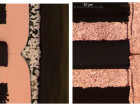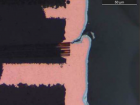Penetrant dye gross leak test is used to identify leakage pathways within hermetic and non-hermetic devices, such as glass body devices or plastic encapsulated parts. The test provides a definitive view of the leak paths including cracks, voids, delaminations and other fractures.
The fluorescent dye penetrant test provides the means to identify failures caused by packaging faults or assembly problems, particularly cracks or voids in the package body with no internal cavities where they can nevertheless lead to deterioration and reliability issues as a result of, for example, exposition to humidity. This method allows to detect such defects being also dedicated to the research of leak origins and mechanisms.
For example, if performed in accordance with MIL-STD-750 method 1071, this test allows to detect the presence of leaks or cracks in glass diodes. The method consists in dipping the samples into a fluorescent dye solution (rhodamine), while being placed in a hermetic chamber and pressurized in order to force the liquid to penetrate the possible cracks, voids or gaps between the glass diode body and the leads. After the cleaning process, the tested samples are examined under high magnification using a UV light source for evidence of rhodamine. Before the inspection, the device can be encapsulated in a transparent resin for cross-sectioning.
This test is performed onto transparent glass encapsulated devices or for destructive verification of opaque devices. Any evidence of dye in the device constitutes a failure and the device is rejected.
- External Visual Inspection Electronic Components | EEE Parts - 9th December 2015
- Internal Visual Inspection Electronic Components | EEE Parts - 9th December 2015
- Penetrant Dye Gross Leak Electronic Components | EEE Parts - 9th December 2015




